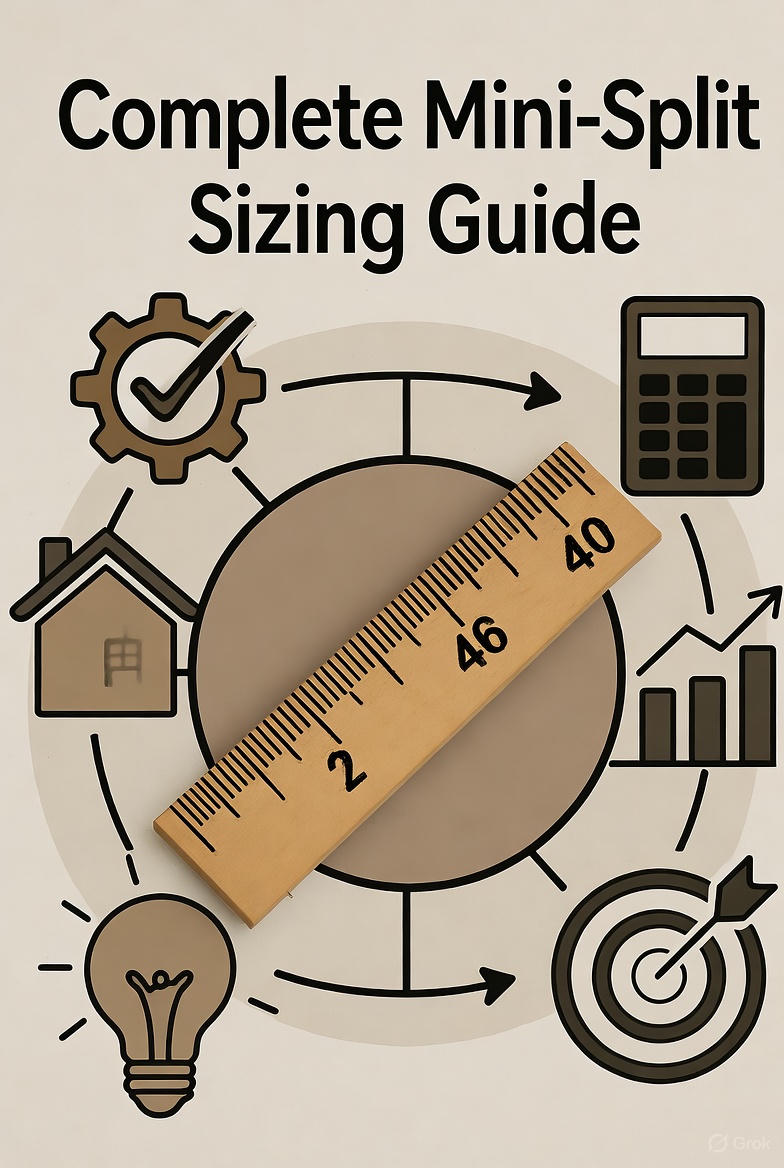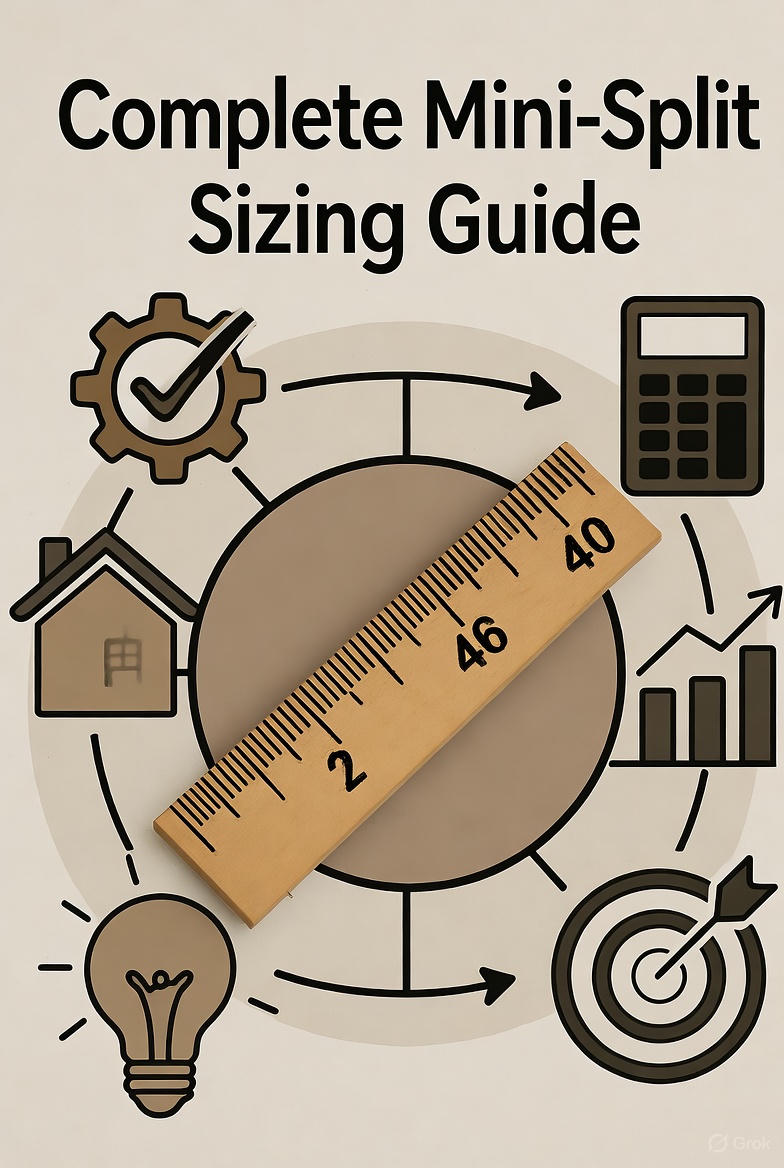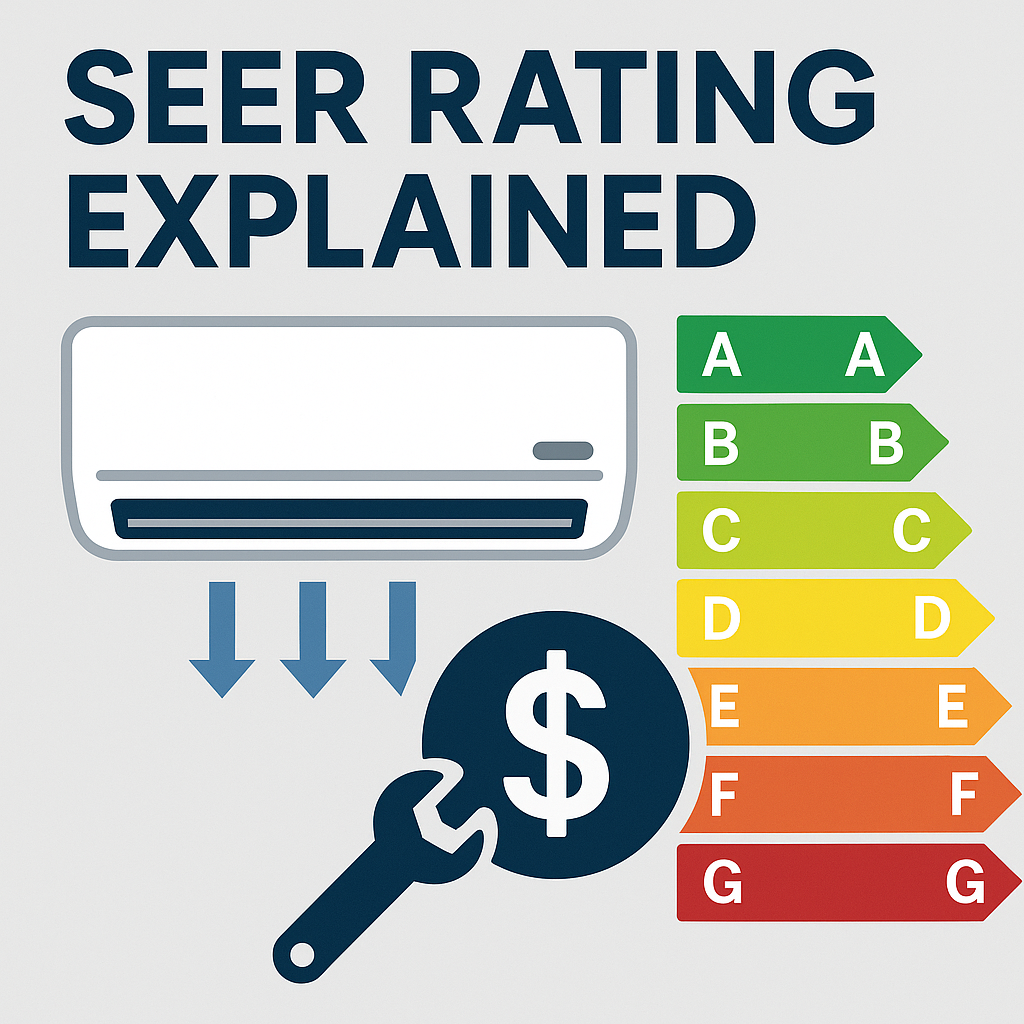Lisa received three different quotes for her 450 sq ft Phoenix living room: 12K, 15K, and 18K BTU. After learning the actual math, she chose 15K—and it transformed her space while using 20% less electricity than the oversized 18K would have consumed.
Oversizing wastes money and creates temperature swings. Undersizing means constant running, high bills, and premature failure. This guide shows you how to size correctly.
Quick Answer: Most rooms need 20-30 BTU per square foot. A 300 sq ft bedroom needs 9,000 BTU. A 600 sq ft living room needs 15,000-18,000 BTU. Use our free calculator for precise recommendations.
Mini Split BTU Sizing Chart (Quick Reference)
This chart provides BTU recommendations for typical spaces with average insulation and 8-foot ceilings. Adjustments may be needed for your specific conditions (covered below).
| Room Square Footage | Recommended BTU | Typical Rooms | Zone Systems | |---------------------|-----------------|---------------|--------------| | 100-150 sq ft | 6,000 BTU | Small bedroom, home office | 9K BTU | | 150-250 sq ft | 6,000-9,000 BTU | Bedroom, small office | 9K BTU | | 250-350 sq ft | 9,000-12,000 BTU | Large bedroom, medium room | 12K BTU | | 350-500 sq ft | 12,000-15,000 BTU | Master bedroom, small living room | 12K BTU | | 500-700 sq ft | 15,000-18,000 BTU | Living room, great room | 18K BTU | | 700-1,000 sq ft | 18,000-24,000 BTU | Large living area, open concept | 24K BTU | | 1,000-1,400 sq ft | 24,000-30,000 BTU | Very large room, loft, studio | Multi-zone or 24K+ | | 1,400-2,000 sq ft | 30,000-36,000 BTU | Whole small home, large open space | Multi-zone systems |
Important: This chart assumes average insulation (R-13 walls), standard 8-foot ceilings, moderate climate, and typical occupancy. Keep reading to learn when and how to adjust these recommendations.

Understanding BTU & Why Sizing Matters
BTU = British Thermal Unit. A 12,000 BTU mini-split removes 12,000 BTU of heat/hour from your space. 1 ton = 12,000 BTU.
Common sizes: 6K, 9K, 12K, 15K, 18K, 24K, 30K, 36K BTU
Wrong sizing consequences:
Oversized (18K in 300 sq ft):
- Short-cycles (on/off 6-8 times/hour)
- Temperature swings (4-6°F)
- Poor dehumidification
- Higher electric bills
Undersized (12K in 650 sq ft Phoenix):
- Can't reach target temp (stuck at 78°F)
- Runs 24/7 ($95/month bills vs. $55)
- 6-year lifespan vs. 15+ years
Properly sized = lowest costs + best comfort + longest life
How to Calculate: 7-Step Formula
Step 1: Base Calculation
- Square footage × 25 BTU = Base requirement
- Example: 400 sq ft × 25 = 10,000 BTU
Step 2: Insulation Adjustment
| Insulation | BTU per Sq Ft | |-----------|---------------| | Excellent (R-30+) | 20 BTU | | Good (R-20) | 22-23 BTU | | Average (R-13) | 25 BTU | | Poor | 30-35 BTU | | Very Poor (garage) | 40-45 BTU |
Step 3: Ceiling Height
- 8 ft: no adjustment
- 9-10 ft: +10-15%
- 11-12 ft: +20-25%
- Vaulted: +30-40%
Step 4: Climate Zone
| Zone | Examples | Adjustment | |------|----------|------------| | Mild | Seattle, SF | 1.0x | | Moderate | NYC, Chicago | +5-10% | | Hot-Humid | Houston, Miami | +15-25% | | Very Hot | Phoenix, Vegas | +25-35% | | Cold | Minneapolis | Size for heating |
Step 5: Sun Exposure
- North: no adjustment
- East/West: +10%
- South: +15%
- Large windows: +10-15%
Step 6: Occupancy & Equipment
- Each person over 2: +600 BTU
- Home office: +1,000-1,500 BTU
- Kitchen: +4,000 BTU
Step 7: Round to Nearest Size
- Available: 6K, 9K, 12K, 15K, 18K, 24K, 30K, 36K BTU
Complete Example: Atlanta Living Room
Jennifer's 396 sq ft room: Vaulted 10-ft ceiling, south-facing large windows, hot-humid climate, 4 people, home office
- Base: 396 × 25 = 9,900 BTU
- Vaulted ceiling: +30% = 12,870 BTU
- Climate (Atlanta): +20% = 15,444 BTU
- South + large windows: +15% = 17,761 BTU
- Occupancy (4 people): +1,200 = 18,961 BTU
- Home office: +1,500 = 20,461 BTU
Result: 24K BTU system
Before (18K): Struggled to reach 76°F. After (24K): Perfect 72°F even on 98°F days.
Room-Specific Quick Reference
| Room Type | Sq Ft | BTU Needed | |-----------|-------|------------| | Small bedroom | 100-200 | 6K-9K | | Medium bedroom | 200-300 | 9K-12K | | Large bedroom | 300-400 | 12K-15K | | Master bedroom | 400-600 | 15K-18K | | Living room | 300-500 | 12K-18K | | Great room | 500-800 | 18K-24K | | Open concept | 800-1200 | 24K-36K | | Garage | Use 40-45 BTU/sq ft | |
Special considerations:
- Kitchen: +4,000 BTU (appliances)
- Sunroom: +25-50%
- Garages: 35-45 BTU/sq ft (poor insulation)
Common Mistakes to Avoid
- "Bigger is better" → Oversizing wastes money, causes short-cycling
- Matching old system → It might have been wrong too
- Ignoring climate → Phoenix ≠ Maine
- Forgetting insulation → Poor insulation needs more capacity
- Not planning ahead → Adding insulation? Size for after
Multi-Zone Sizing
Rule: Indoor units can exceed outdoor capacity by 25-30% (not all run at max simultaneously)
Example 3-Zone:
- Master (350 sq ft): 12K BTU
- Living (600 sq ft): 18K BTU
- Office (200 sq ft): 9K BTU
- Total indoor: 39K BTU
- Outdoor unit: 36K BTU (supports up to 45K indoor)
Heating vs. Cooling
Cold climates (Minnesota, Maine): Size for heating at design temp (-10°F). A 12K cooling system may only provide 8-9K heating at -5°F. Choose cold-climate models rated to -13°F.
Hot climates (Phoenix, Miami): Size for cooling load. Standard calculations work.
Moderate climates: Cooling and heating loads similar. Standard sizing.
Between Sizes? Choose Wisely
Example: Need 11,500 BTU
- 12K BTU: 4% oversized (safe choice)
- 9K BTU: 22% undersized (not recommended)
Within 10-15%?
- Better insulation → smaller size
- Worse insulation → larger size
- Hot climate → larger size
Cost of Wrong Sizing
| Sizing | Equipment Cost | 5-Year Operating | Total Loss | |--------|----------------|------------------|------------| | Too Small | Save $200-$500 | +$1,000-$2,000 extra | -$1,000 | | Too Large | +$200-$800 extra | +$500-$1,000 extra | -$1,550 | | Correct | Optimal | Optimal | Best value |
Bottom Line
Simple method:
- Sq ft × 25 BTU = base
- Adjust for insulation, ceiling, climate, windows
- Use sizing calculator to verify
When in doubt:
- Use free calculator
- Size up 10-15% if uncertain
- Call Zone support (free consult)
FAQ
What size for a 12×12 room (144 sq ft)? 6K-9K BTU. Calculate: 144 × 25 = 3,600 BTU base, then adjust. Typically 9K BTU.
What size for 500 square feet? 12K-15K BTU in moderate climates. Hot climates or poor insulation may need 18K BTU.
Can one unit cool multiple rooms? Yes, if open floor plan (no closed doors) and similar temp needs. For separate closed rooms, use multi-zone.
9K, 12K, or 18K BTU?
- 9K: Up to 350 sq ft, average conditions
- 12K: 350-550 sq ft
- 18K: 550-850 sq ft, or challenging conditions
Too small = what? Runs constantly, can't reach target temp, high bills, premature failure. Size up if between sizes.
Too big = what? Short-cycling, poor dehumidification, temperature swings, higher operating costs.
Size for heating or cooling? Cold climates: heating. Hot climates: cooling. Moderate: cooling (usually larger load).
Does ceiling height matter? Yes! 12-ft ceilings = 50% more air vs. 8-ft. Always factor this in.
Garage formula different? Yes. Use 35-45 BTU/sq ft (vs. 25 for living spaces). Poor insulation, concrete floors, large doors.
Tons vs. BTU? 1 ton = 12,000 BTU/hour. A "2-ton system" = 24,000 BTU.
About the Author: Scott Skidmore is a Senior HVAC Engineer at Zone Air with over 12 years of experience in mini-split system design and load calculations. He's personally sized over 8,000 installations across all 50 states and every climate zone. Scott holds ACCA Manual J certification and regularly trains HVAC professionals on proper sizing techniques. His passion is helping DIY homeowners avoid the costly mistakes of over- or under-sizing their systems. When not crunching BTU calculations, Scott tests new equipment in extreme conditions to verify manufacturer specifications match real-world performance.
Related Articles:



